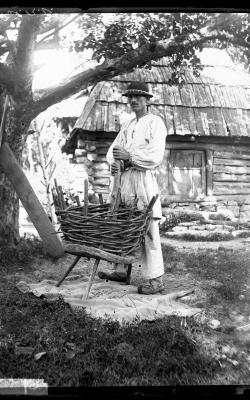Autumn is the time when corn is also harvested, a nutritious food that entered the traditional diet only in the 18th century. Although sensitive to climatic conditions, and its cultivation requires more periodic maintenance works, corn has expanded at the expense of other cereals, adapting even to higher areas, and being cultivated on sunny slopes. After harvesting, corn was transported home, usually stored in the barn, where cobs were also opened. After cobs were dried, they were flailed (an operation that separated kernels from the cob).
Various tools were used for this activity: metal hand scrapers; wooden mallets; scrubbing chairs; flailing baskets etc. The basket for flailing corn was also used in Hațeg Country, as it can be seen in the photo taken by Romulus Vuia, in the yard of a household from Federi (Feger) village, Pui region, Hunedoara county. The man, dressed up in a specific folk costume, wears a dark felt hat with a round brim and wide borders, decorated with a strip of polychrome beads.
The long, homespun shirt with wide sleeves finished with wristbands (“pumnași”) has a straight, narrow band-like collar. The geometric decoration is arranged at the collar, at the mouth of the shirt (located centrally) and wristbands. The sheets of the shirt are finished with white keys, framed with colored threads, in the shoulder area and along the sleeve. The man has a belt around his waist. The home cloth is also used to make wide, simple, unadorned drawers. In his feet, he wears woolen socks and foot plates with tips, tied on the leg with straps.
The man in the picture pounds the corn with a wooden “pilug” (a long, round, thick stick), carved at the top, into a basket with walls of weaved rods and a wooden bottom, perforated, to let the kernels fall out. The three-legged basket is placed over a woolen cloth that was used to collect the corn kernels. The rectangular-shaped fabric, with decoration on three sides and tassels on one end, appears to be a worn piece of textile, probably an unfolded hood (“cășulă”). The negative, registered with title “Basket for cleaning corn”, with inventory no. 8, is made in the gelatin-silver bromide technique on glass support, with dimensions of 9 cm x 12 cm.
Photo: the MET archive











